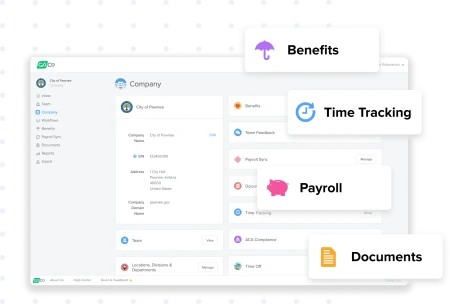The Rise of the Decentralized Organization
In today's increasingly fast-paced business environment, companies are experimenting with a variety of decentralized structures
March 15th, 2023
Around the world, the hierarchy has long been known as the standard organizational structure.
However, organizations from startups to multinational corporations are coming to view flatter, more egalitarian structures as much more effective than hierarchies.
Don’t have time to read the entire guide right now?
Let us send you a free downloadable version so you can read it when it’s more convenient for you
In today's increasingly fast-paced business environment, companies are experimenting with various decentralized structures. In some cases, decentralization represents the full culmination of the organization's vision; in others, it's a response to changing times.
Table of Contents
What is a Decentralized Organization?
A decentralized organization is a unique business structure that promotes a power distribution model, wherein decision-making responsibilities are diffused across multiple levels rather than being monopolized by the senior leadership. This structure empowers mid and lower-tier managers, and often even team members, to make decisions that directly influence their respective domains, cultivating a culture of teamwork, inclusivity, and shared responsibility.
This stands in contrast to a centralized organization, where decision-making is strictly hierarchical and largely controlled by the highest-ranking leaders or executives. However, it's crucial to understand that these structures operate on a spectrum - businesses may display a blend of centralization and decentralization varying degrees, depending on their specific needs, objectives, and strategic vision.
Decentralization brings numerous advantages, including fostering innovation, enhancing responsiveness, and boosting employee engagement. Nevertheless, it also presents challenges such as potential inconsistencies in decision-making and the need for effective communication networks. Therefore, it's pivotal for businesses to carefully evaluate their unique circumstances and strategic goals to determine the optimal degree of decentralization.
In a decentralized organization, decision-making happens as low on the chain of command as possible, explain O. C. Ferrell, John Fraedrich, and Linda Ferrell in Business Ethics 2009 Update: Ethical Decision Making and Cases.
The teams must still ensure their actions align with an agreed-upon vision and broader plan. However, they might make up their own rules and determine their individual processes, reaching a consensus as a team.
Divisions of a decentralized company might independently handle all aspects of their operations or only particular ones, say Carl S. Warren, James M. Reeve, and Jonathan Duchac in Accounting. They might exist in the same building or over a broad geographical space.
Andrew J. DuBrin, in Essentials of Management, asserts that no company is fully centralized or decentralized. Instead, there are degrees of both. The degree of decentralization right for a company depends on its size, culture, and strategy.
In my small business, decentralization has so many benefits: driving down overhead, decreasing reoccurring expenses, remaining lean, sourcing products, outsourcing activities by specialization to minimize time, and using scarce resources more efficiently.

Franchises embody a combination of centralization and decentralization, says DuBrin. For example, he explains that Subway gives local stores control over hiring and onboarding, but a centralized headquarters decides things like menus and marketing.
Johnson & Johnson, well-known for its decentralized structure, has over 200 autonomously functioning units. Some focus on particular product components, requiring cooperation between such units.
According to Forbes, a more extreme level of decentralization that aims to eliminate hierarchy usually won't work for a massive corporation. Often called a "flat" structure, this tends to work best for smaller startups and medium-sized companies. The gaming company Valve has embraced this structure, eliminating job titles and allowing employees to work on or initiate any project they choose. Such a structure might germinate a great deal of creativity within a young company, but it will probably need to be adapted as the company grows.
Decentralization reduces the time to make decisions. Managers can execute and implement decisions on matters affecting their departments quickly and accurately.
Roots of Decentralization
The dominant societal institutions – namely, the government, the military, and the church – have long had a centralized structure, so it's natural that corporations followed suit by embracing centralization as the standard.
As the team-based approach has gained prevalence in the corporate world, companies have worked to create more egalitarian structures that model values of teamwork and individual empowerment.
The military's movements toward decentralizing combat units have also provided lessons for the corporate world. In the Iraq war, when Al-Qaeda forces won battles, the US Army moved to empower highly trained combat units to make their own decisions in real time. Their increased agility and connection to a centralized information hub paid off.
However, decentralization is hardly a new concept. According to BusinessNews Publishing, industries tend to move back and forth between being more centralized and decentralized depending on an array of societal forces.
Early railroad companies in the US were largely decentralized, and this structure worked quite well for them, Gerrit Broekstra explains in Building High-Performance, High-Trust Organizations. Still, this didn't last too long. According to Broekstra, the banking industry's focus on the centralized structure would largely eradicate decentralization from American industry by the end of the nineteenth century.
Technology makes decentralization not just possible but preferable in many scenarios. I've worked in a decentralized way for over 20 years. As a digital marketer, I source people from all around the world. This gives me access to a much larger talent pool than those in my local area.

8 Benefits of Decentralization
Taking steps toward decentralization can produce major results when a company pinpoints the right level of decentralization for its operations.
1. Flexibility
Decentralized organizations have a great deal of flexibility compared to centralized ones. They can adapt to change or make decisions quickly instead of putting every decision through a rigorous bureaucratic review. Nowadays, change happens too fast for hierarchical organizations to respond to it.
2. Information-processing ability
New and emerging systems constantly aggregate vast user data and information on company performance. Centralized management simply can't respond effectively to such information in a timely manner. Specialized teams with narrow areas of focus are much more agile.
3. Increased morale
Decentralizing allows more employees to step into leadership roles, giving them a sense of empowerment. In turn, the organization can benefit from having many empowered leaders rather than a select few.
Decentralization boosts employee motivation. More junior team members feel empowered because they are involved in important activities and decisions.
4. Development of expertise
As a result of this narrow focus, managers in divisions of a decentralized corporation have expertise in managing within a particular area of operations.
5. Error mitigation
According to William Weldon, former chair and CEO of Johnson & Johnson, "The problem with centralization is if one person makes one mistake, it can cripple the whole organization." He asserts in a decentralized company, "you don't have to worry about making that one big mistake."
6. Ability to pinpoint strengths and weaknesses
Decentralization also helps companies pinpoint where mistakes and successes occur. In 1999, Forbes wrote about Illinois Tool Works, a highly successful decentralized company. Split into an array of units, each handling a different function. The company would split up units even further if it started outperforming or falling behind the competition. Decentralization allowed the company to pinpoint exactly what was working and what wasn't based on the successes and failures of particular units and manage performance accordingly.
7. Reliance on local insight
Decentralization makes sense in a globalized world because local talent has more insight into how to market to and manage their own people. In Japan, local business people run Johnson & Johnson's operations for this very reason.
8. Ability to cope with adversity
Decentralized companies are more "recession-proof," according to a recent study. Rather than a centralized CEO making aggressive job cuts and plant closures, local staff buckle down and find ways to boost productivity.
The purpose of a decentralized organization is to involve employees at every level of strategic planning and the day-to-day running of the business. However, if lower-level team leaders or supervisors still have to consult the senior executives when making a simple decision, the entire system just becomes too cumbersome.

4 Challenges of Decentralization
Companies working to decentralize should negotiate the following challenges:
1. Implementing change
Implementing organizational changes in a decentralized company may take a long time as there may not be a fast, clear, or accepted system for making such changes.
2. Coordination between teams
This poses a primary challenge for decentralized organizations. In such companies, teams can become information silos. Developing individuals' ability to collaborate across teams is the solution.
3. Redundancy of roles
Additionally, decentralization can lead to the redundancy of roles across divisions. Different sales or customer service staff might be hired for different divisions instead of one set of staff to fulfill this function. That's not necessarily a problem if they're more effective than one centralized staff set, but a company must evaluate whether avoiding such overlap is beneficial.
4. Social impacts
Ferrell, Fraedrich, and Ferrell point out the potential implications of decentralization on corporate social responsibility. It's possible that lower-level teams authorized to make decisions about something impacting the community won't make the most ethical or informed decisions, which impacts the whole company's reputation. Oversight of such decisions or having people with relevant expertise on such teams can remedy this issue.
Decentralized Autonomous Organizations
Decentralization can go a step further: decentralized autonomous organizations. Such an organization is a vast system (or a system with the potential to become vast) that adapts to user needs, tracks spending and preferences, and dispurses profits without centralized oversight.
In such organizations, blockchain technology allows the system to function entirely without centralized management. The system has a mechanism for generating feedback loops about user preferences to adapt products, services, or even system rules according to their needs.
Decentralization distributes power and decision-making across the organization, leading to a more democratic and inclusive workplace culture.
Blockchain technologies also have the ability to safeguard users' privacy, as no centralized authority needs to have their information.
These technologies keep an electronic record of user data and transactions that requires no centralized accounting. Bitcoin is one of the best examples. The currency functions wholly without a centralized bank, automatically tracking what all users send and receive.
Such organizations may distribute profits to users throughout the network rather than to a centralized hub, as stated by Forbes.
These systems are still in the experimental stages, but some companies partially follow such a framework – Uber is one example.
Evolutionary theory can be considered as forming the basis of these organizations. Through the selection of members, a product or service evolves over time; it's never seen as "finished."
When the COVID pandemic hit, our company completed a switch to a remote work environment. We had already begun the switch, as I left working in hospitals to be location independent, and I wanted that for my team as well.
We had a centralized decision-making process when working out of the office. Going remote provided an enormous set of challenges for our company of around 30 employees. We had different schedules and work habits working from home. We have gradually switched to a more decentralized company, and I have bought into the productivity it can inspire.

Does Decentralization Work For Established Companies and Startups?
Decentralizing a long-standing company might take perseverance, as hierarchical structures are deeply entrenched in the corporate world. However, many corporations have successfully made bold moves toward decentralizing their operations. As such, organizations tend to have many experienced employees ready to take on greater leadership roles. Decentralization can significantly boost their morale and capacity.
Corporations should carefully evaluate the degree of decentralization that will work for their size. Extreme decentralization is not necessarily better.
Zappos, for instance, made a move toward something called holacracy, which gets rid of centralized hierarchy by eliminating titles and bosses. However, employees began leaving in droves (taking the company up on its buyout option) because of confusion and dwindling motivation – after all, there was no career ladder to climb, reports The Atlantic. Whether the tide will turn for Zappos' experiment with holacracy remains to be seen.
Creating and empowering smaller divisions with decision-making authority while retaining centralized corporate oversight may be wiser for most large companies.
For instance, Unilever decentralized as it expanded, with its divisions throughout the world acting as "self-sufficient units" that could respond effectively to local market conditions. However, it hasn't done away with headquarters and job titles yet.
Startups might be too small to have much to decentralize, but it's never too soon to start planning how the structure will evolve as the company grows. Putting a plan in place before the company expands will ensure those tough decisions don't have to be made just when business is booming and onboarding new hires. It's crucial to know where they fit in before they arrive.
If you're considering changing your organizational structure, ask yourself how it should look as your company expands. Imagine how it might shift five or ten years down the road. You'll be more agile and able to seize opportunities when you're prepared to delegate well.
Examples of Decentralized Organizations
As we venture further into our exploration of decentralization within businesses, it becomes increasingly beneficial to understand how this concept materializes in real-world scenarios. By examining how some leading global organizations have adopted and implemented decentralization strategies, we can better appreciate its practical implications and potential advantages.
Spotify: The music streaming giant uses a model often referred to as the 'Squad' model. This model decentralizes decision-making by empowering small, cross-functional teams (squads) to work independently on different aspects of the product. Each squad is autonomous and has the authority to decide what to work on and how to do it.
Valve Corporation: This video game developer is famous for its flat organizational structure, with no job titles or bosses. Employees are encouraged to start their own projects and teams, make major strategic decisions, and move between projects as they wish.
Gore-Tex: This materials science company is known for its "lattice" structure, where there are no traditional organizational charts, no chains of command, nor predetermined channels of communication. Instead, they communicate directly and are encouraged to take initiative.
Buurtzorg: This Dutch home-care organization has an innovative management model where nurse teams operate independently, making critical decisions relating to patient care.
Zappos: The online shoe and clothing retailer has been experimenting with a decentralized management style called 'Holacracy', which removes power from a management hierarchy and distributes it across clear roles, which can be executed autonomously without a micromanaging boss.
Haier: A Chinese multinational consumer electronics and home appliances company has implemented a "Rendanheyi" model that breaks the company into small, self-managing units that operate like startups.
Final Thoughts
The traditional hierarchical structures in businesses are being redefined. Organizations are increasingly shifting towards more agile, adaptable, and empowering operation models.
However, it's important to remember that the journey toward decentralization is not a one-size-fits-all approach. The level of decentralization that works best for an organization depends on its size, culture, and strategic vision. Businesses must consider their unique circumstances and goals when deciding how to implement or balance decentralized structures.
Decentralization, while not without its challenges, can change the game in how organizations operate, unlocking new levels of creativity and productivity. As organizations continue experimenting with different degrees of decentralization, we expect to see more innovative, resilient, and efficient business models arise.
So, whether you're a startup founder envisioning a flat structure for your future team or a seasoned executive contemplating a shift from the traditional hierarchy, remember - the key is finding the best balance for your unique organization. Ultimately, the goal of decentralization is not just to disrupt for the sake of disruption but to create organizations where every individual feels empowered, engaged, and integral to collective success.
As we move forward in this fast-paced business environment, there is no doubt that the exploration and implementation of decentralization will continue to evolve. So, keep your eyes open, stay flexible, and don't be afraid to experiment. After all, the future of work is in our hands, and it's up to us to shape it in a way that promotes innovation, inclusivity and shared responsibility.

Subscribe to Beyond The Desk to get insights, important dates, and a healthy dose of HR fun straight to your inbox.
Subscribe hereRecommended Posts
The State of Health & Safety In HR Report
Blog Articles
22 Employee Engagement Ideas That Remote Workers Love
Blog Articles
Search...
Product
GoCo
Resources
Articles
eBooks
Webinars
Customer Stories




![How To Build a Business Case For HR Software [Free Calculator]](/img/containers/assets/goco/featured_images/posts/build-business-case-for-hr-software.png/523e57aedee519da6f963895c12ba0e0.png)

